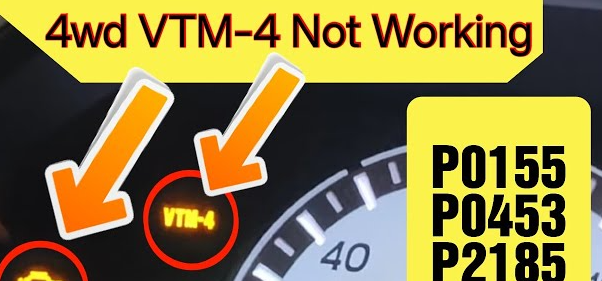You’re cruising along in your Honda Pilot when suddenly an unfamiliar light pops up on the dash – the VTM-4 indicator. This puzzling symbol is trying to tell you there’s a problem with your vehicle’s 4-wheel drive system. But what exactly does the VTM-4 light mean, and how can you get it turned off?

Don’t panic! This guide will break down everything you need to know about the VTM-4 warning light on Honda Pilots. We’ll explain what systems it monitors, common reasons why it might illuminate, and most importantly, how to diagnose and fix the underlying issues causing it to activate.
By the end, you’ll be armed with the knowledge to take action and be back to enjoying your Pilot’s capable 4WD performance again.
What is the VTM-4 System?
First, let’s go over exactly what the VTM-4 system does on Honda Pilots. VTM stands for “Variable Torque Management” and the 4 indicates it’s a 4-wheel drive system.
The VTM-4 system automatically adjusts how much torque (rotational power) is supplied to the front and rear axles based on driving conditions. It uses an array of sensors and computers to seamlessly distribute torque between all four wheels to maximize traction, handling and stability.
When everything is operating as designed, the VTM-4 system enhances the Pilot’s capabilities on slippery roads, steep inclines, and other low traction situations where 4WD traction is beneficial. It also boosts fuel efficiency by only activating the rear wheels when extra traction is needed.
So when that bright yellow VTM-4 dash light comes on, it means a fault has been detected somewhere within these drivetrain systems that requires your attention.
Check Differential Fluid Levels
One of the most common culprits behind an illuminated VTM-4 light is low differential fluid levels. The VTM-4 system uses special fluid to transfer power between the front and rear axles.
To check differential fluid:
- Park on level ground and apply parking brake
- Locate the differential fill plugs (front and rear)
- Remove plugs and fluid should be at or near the fill hole
- Top up using Honda VTM-4 differential fluid if levels are low
“My Pilot’s VTM-4 light had been on for months, even after trying some basic fixes. Turns out I just needed to refill the rear differential fluid that was very low – problem immediately went away after topping it up!” – Pilot Owner Forum
Low differential fluid levels can lead to damage and excess friction that triggers the VTM-4 warning. Refill the fluid reservoirs to resolve this common issue. Check also: Why is the D Light Blinking on Honda.
Inspect for Fluid Contamination
Another potential reason for the VTM-4 light: Contaminated differential fluid that has degraded over time and needs to be serviced.
You’ll want to look for:
- Dark, sludgy fluid indicating breakdown
- Small metallic particles indicating wear
- Burnt odor or frothed, foamy fluid
If the fluid appears contaminated in any way instead of being relatively clean and translucent, it’s likely due for a full flush and refill of the entire system.
The VTM-4 design uses clutch packs and pumps that can become clogged and damaged by deteriorated fluid over tens of thousands of miles. Don’t ignore the light if caused by sludgy old differential oil.
Diagnose Potential System Faults
For illuminated VTM-4 lights that can’t be solved by tending to the fluids, you’ll want to move onto diagnosing potential mechanical or electrical faults within the 4WD system itself.
Components that could be triggering the VTM-4 light:
Wheel Speed Sensors: Detects individual wheel speeds to control torque delivery. Faulty sensors cause system errors.
Control Module: Brains of the VTM-4 operation. Buggy software or internal module failure requires replacement.
Solenoids/Clutch Packs: Control flow of fluid to front/rear axles. Sticking or leaking solenoids and worn clutches illuminate VTM-4 light.
Electrical Issues: Wiring, fuses, connectors related to system. Shorts or damaged electrical components trigger alerts.
Due to the complex electronics involved, you’ll likely need to visit a Honda dealer or transmission specialist for proper diagnosis. They can use scan tools to pinpoint trouble codes and test the VTM-4 components directly.
“Took my Pilot in to the dealer when the VTM-4 light wouldn’t go away after trying some basic stuff. Ended up having two bad wheel speed sensors, got them replaced and that fixed the warning indicator.”
Don’t ignore the VTM-4 light, as it indicates a fault that could lead to larger 4WD system issues down the road if not repaired properly.
Key Takeaways
Getting that pesky VTM-4 warning light on your Honda Pilot? Here are the key things to check:
- Inspect differential fluid levels and top up if low
- Change differential fluid if it appears contaminated or old
- Diagnose for issues like faulty wheel speed sensors, control module, clutch packs, etc.
- Have a shop scan for VTM-4 trouble codes and test electronic components
- Don’t ignore the light, as it indicates a potential driveline fault
By taking the time to properly troubleshoot and diagnose the reason behind your Pilot’s VTM-4 light, you can address the root cause and clear the warning message. This ensures your Honda’s advanced 4WD system continues providing optimal traction and performance for years to come!








